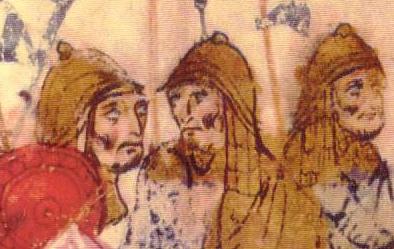Despite what Hollywood may say, the Vikings did not have horns on their helmets. The most common helmet of the Viking period was a simple cone shape with a nasal or nose-guard. Here are some examples.

"Nasalhelm" from Moravia, probably German
 Russian - belonged to Prince Jaroslav Vsedolodovich - Early 13th century
Russian - belonged to Prince Jaroslav Vsedolodovich - Early 13th century


From the Bayeux Tapestry (Anglo-Norman, approx. 1070 AD)

Viking head carved on reindeer antler
The first helmet was forged from a single piece of steel without a seam. The next two are made the same way, and also have separate nasals, one with "eyebrows". The rest of the helmets are spangenhelms, made from several plates riveted either to each other or to an iron framework.
As you can see, there is a lot of variety on the basic design.
For instructions on making a spangenhelm, click here

An illustration from the Chronicle of John Skylitzes, a Byzantine historian, kept in the Bibliot’eca Naçional in Madrid, probably from the 12th century
This picture shows three types of Byzantine helmet - the two at the far left are made of many narrow segments rivetted together to form a cone (a type also used by the Empire's foes, the Turks and Normans.
For instructions on making this type of helmet, click here
The next two are simple helms, deeper at the back to protect the skull,as also seen in this illustration, also from the Madrid Skylitzes Chronicle.

For instructions on making this type of helmet, click here
The helmet at the far right appears to be in two parts - a lower body with a conical addition rivetted to it at the top.

Note also the rear view of an aventail.
Byzantine helmets nearly always had a ring or knob on top, perhaps to secure a plume. They usually didn’t have nasals, so they’re not as good for face protection as the Viking styles.

The illustration above, from the Chronicle of John Skylitzes, a Byzantine historian, kept in the Bibliot’eca Naçional in Madrid, shows helmets which seem to be built up from concentric strips of metal.
For instructions on making this type of helmet, click here
Warning - not for beginners.More Byzantine helmets. The first, again from the Skylitzes Chronicle, shows a hemispherical style; the second shows two views of a peaked helmet of strangely modern design. This helmet incorporates an aventail of flexible (leather?) strips.
Pictures to comeWhen making your own helmet, use these types as a guide. You don’t have to copy them exactly; there were thousands in existence, of which maybe a few dozen have been unearthed. However, you should follow the general style shown here. You can probably find others in libraries, but remember to use Primary Sources, not pictures from hundreds of years later, which might be pure invention. For neck protection, the mail coif was popular in Western Europe, while aventails were mostly preferred in the East, though there are plenty of exceptions in both cases.
A spun dome is a steel helmet shell, mass-produced on a machine. Of course unlike the hand-made helmets of the Middle Ages, they’re all the same shape. Also, the spinning process can produce lots of narrow grooves around the dome, which look really terrible unless they are removed with a sanding disc.
It is preferable to make a helmet from scratch as described above - most helmets of our period were - but if you do use a spun dome, put in the extra effort - grind off any grooves that are on it and do something to make it look individual. Alter the shape of the helmet a bit, or add metal strips so it looks like the spangenhelm above, perhaps add an ornate nose-guard. Look at pictures of actual helmets and try to emulate them. It’s surprising how little work it takes to turn a mass-produced shell into something you can be proud to wear.
This Byzantine helmet replica, made from a spun dome, show what you can achieve with a little effort and imagination.

For instructions on making this type of helmet, click here
Text and construction drawings copyright (c) 2002 by Steven Lowe.
The material in this page is for research purposes only. Permission to reproduce material from this manual with author acknowledgment is granted for non-commercial purposes.
Last Updated 30 June 2003